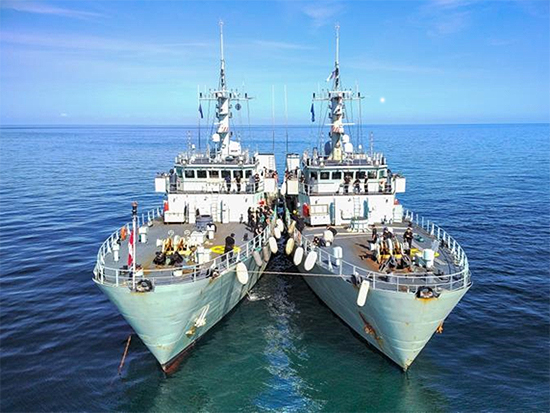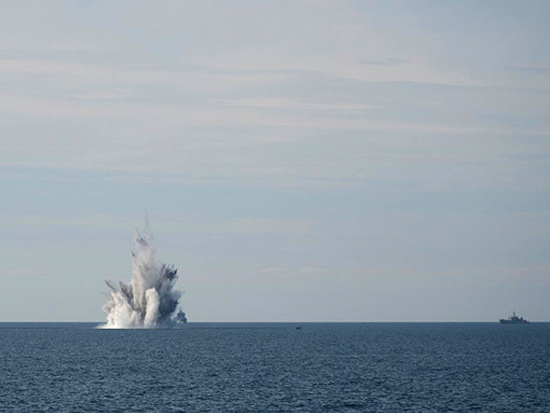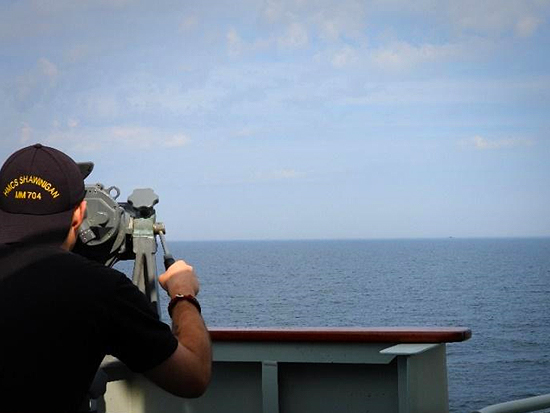Canada’s Naval Presence in Northern Europe: HMCS Glace Bay and HMCS Shawinigan on Operation REASSURANCE
October 31, 2024 - Defence Stories

Caption
HMCS Glace Bay and HMCS Shawinigan at anchor on the Kattegat off the coast of Denmark, on 1 August 2024 while deployed on Operation REASSURANCE with Standing NATO Mine Countermeasures Group 1.
In the cool waters of Northern Europe, HMCS Glace Bay and HMCS Shawinigan have been playing a pivotal role in maintaining maritime security alongside NATO Allies since departing Halifax in July. These Kingston-class Maritime Coastal Defence Vessels (MCDVs) have deployed under Operation REASSURANCE and are part of Standing NATO Mine Countermeasures Group 1 (SNMCMG1), an Allied effort that ensures the safety and security of European waters. The missions are wide ranging; they encompass historical ordnance disposal operations (HODOPS) as well as vigilance and presence at sea activities, providing critical “eyes and ears” for the Alliance at a time of increased tensions.
Operation REASSURANCE represents Canada’s commitment to NATO’s collective security and is currently the largest Canadian Armed Forces operation. For Canada, participating in SNMCMG1 provides an opportunity to showcase the Royal Canadian Navy's versatility, dedication, and professionalism, contributing to Allied efforts in a significant way.
SNMCMG1 is a multinational NATO force, and interoperability is key to its success. Canadian sailors regularly engage in joint exercises and activities with other Alliance ships, honing their skills and building the relationships necessary for successful combined operations.
Historical Ordnance Disposal Operations: Safeguarding Sea Lanes

Caption
Petty Officer First Class Brian Bourassa (left) a member of His Majesty’s Canadian Ship Glace Bay prepares a REMUS 100 Autonomous Underwater Vehicle (AUV) for operation on the Kattegat off the coast of Denmark, during Operation REASSURANCE on 16 August 2024.
One of the missions undertaken by HMCS Glace Bay and HMCS Shawinigan as part of SNMCMG1 is HODOPS, and the importance of this mandate cannot be overstated. These waterways are some of the busiest in the world, and the presence of legacy munitions represents a significant risk to safe passage, with some estimates anticipating upwards of 80,000 naval mines and ordinance pieces left over from the First and Second World Wars.
The task of locating and safely disposing of these underwater dangers falls to embarked specialized teams. These teams are equipped with the REMUS 100, an Autonomous Underwater Vehicle (AUV) that is compact, lightweight, and designed for operations in coastal environments. The REMUS 100 provides large area coverage on a single mission while side scan sonar and precision navigation provides highly accurate data to locate targets, enabling operators to accurately map the ocean floor. After potential targets are identified, clearance divers enter the water to inspect the potential threat and identify what it is. If a legacy munition is identified, a threat assessment is conducted to determine if the munition can be safely disposed of through the judicious use of a C4 explosive charge.
Even if these operations do not end with a bang followed by a towering column of water rising from the sea surface, the goal of HODOPS is to prove an area of the sea is clear of legacy munitions. The reward when conducting HODOPS is knowing that an area is safe for maritime passage.
Vigilance at Sea: NATO’s Eyes and Ears in Northern European Waters

Caption
Master Sailor Hector Ladron De Guevara and Lieutenant (Navy) Alex Castagna, members of the diving team embarked on His Majesty’s Canadian Ship Glace Bay, prepare C4 explosives prior to a practice mine disposal exercise on the Kattegat off the coast of Denmark during Operation REASSURANCE on 12 August 2024.
In addition to conducting HODOPS, both HMCS Glace Bay and HMCS Shawinigan play a crucial role in security on the water by participating in vigilance at sea activities with other NATO vessels. This aspect of their mission is focused on maintaining the security and stability of NATO’s northern flank by serving as vital surveillance platforms, providing invaluable maritime domain awareness. The waters in Northern Europe, particularly in the Baltic and North Seas, are strategic choke points that have been important since the dawn of naval operations. Today, they remain areas of significant global importance.
This mission was best illustrated during an event which occurred from August 29 to September 1, 2024, when HMCS Shawinigan was assigned the task of locating and monitoring the Russian Kilo-class submarine Novorossiysk and its supporting tug Evgeny Churov as they sailed from the Baltics and into the North Sea. The monitoring of both ships was later handed off to HMS Iron Duke in a carefully coordinated operation as the Russian vessels entered the Dover Strait.
HMCS Glace Bay also provided unique support to vigilance at sea activities conducted by SNMCMG1 by demonstrating the ability to monitor Critical Undersea Infrastructure (CUI). Using the REMUS 100, HMCS Glace Bay was able to conduct scans of CUI in the vicinity of the Faroe Islands, establishing this as a capability that Canadian vessels bring to the table when sailing in a NATO Task Group. This is of great importance given the renewed interest in monitoring and safeguarding Alliance CUI.
No Such Thing as a Routine Sail
The deployment of HMCS Glace Bay and HMCS Shawinigan to Northern Europe as part of Operation REASSURANCE is more than just a routine naval mission. It represents Canada’s ongoing commitment to the security of its Allies during a period of increased global tensions. Through their efforts, sailors on both ships are ensuring that the remnants of past conflicts do not endanger lives in the future and that the present remains safe for all.

Caption
A naval mine is disposed of with C4 charges placed by clearance divers with Standing NATO Mine Countermeasures Group 1 during a mine disposal demonstration on the Kattegat off the coast of Denmark during Operation REASSURANCE on 15 August 2024.

Caption
A member of HMCS Shawinigan observes the Russian submarine Novorossiysk during a monitoring mission which took place from 29 August to 1 September 2024 in the Baltic and North Seas.

Caption
The Russian submarine Novorossiysk as photographed by a member of HMCS Shawinigan during a monitoring mission which took place from 29 August to 1 September 2024 in the Baltic and North Seas.

Caption
A sonar image taken by the REMUS 100 Autonomous Underwater Vehicle (AUV) shows Critical Undersea Infrastructure (CUI) in the vicinity of the Faroe Islands on 6 September 2024.